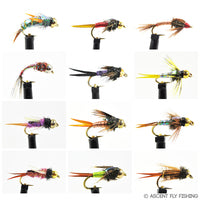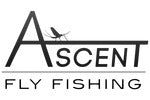
Fly Selection 101: Introducing the ATTRACTOR FLY Patterns
Like a high-stepping line of Las Vegas showgirls or the cast of Baywatch, the family of flies called Attractors rely more on flash and embellishment than attempting to represent any true invertebrate species. Making up roughly 20% of dry patterns and 30% of wet patterns, flies from this family are dressed in tinsel, copper, mirrored Mylar, and flamboyant color, which makes them stand out like Elton John strolling through a rodeo as they drift down the stream.
To the frustration of bug geeks like myself, in spite of these patterns often only resembling a true invertebrate in profile alone, fish will often pass up more realistic patterns to take a swipe at a flashy Attractor. To understand just why attractors are so successful, we need to take a look into the world and minds of trout.
In the cold water lakes and rivers that trout call home, they are at the top of the food chain, the alpha predators, the top dogs. When trying to illustrate this point to clients, I often invoke an image of the lions of the African plain. Like the lion, trout are on the prowl for easy picking, wanting to pack in as much protein as they can while expending as little energy as possible. To do this, both the lion and the trout will focus on the prey that strays from and looks different from the herd. The bright colors and iridescent shine of the attractor make it stand out from the thousands of naturals drifting through the water and incite that carnal nature of the predator! They just can't help themselves and have to take a bite!
Elements of the Attractor are often incorporated into tried and true patterns like the Flashback Hares Ear and Flashback Pheasant Tail nymphs, but for the full shock and awe effect of the Attractor pattern in all of its glory, I would recommend that you keep these dozen patterns on hand:
Sizes: 10 - 22
Imitates: Mayfly & Stonefly Nymphs
Sizes: 10 - 22
Imitates: Midges, Chironomids, Mayfly & Stonefly Nymphs
Sizes: 12 - 18
Colors: Copper, Red, Black, Purple, & Chartreuse
Imitates: Mayfly & Stonefly Nymphs
Sizes: 12 - 20
Imitates: Mayfly & Stonefly Nymphs
Sizes: 16 - 22
Imitates: Midge and Chironomid Larva
Sizes: 20 - 22
Colors: Black, White, Chartreuse, Red, Purple
Imitates: Midge & Chironomid Pupa
Sizes: 12 - 20
Imitates: Mayflies & Midges
Sizes: 10 - 24
Imitates: Mayflies & Midges
Sizes 12 - 20
Imitates: Caddis & Small Stoneflies
Sizes: 12 - 18
Colors: Yellow, Red, Purple, Orange, Chartreuse
Imitates: Mayflies
Sizes: 8 - 14
Colors: Purple, Green, Yellow
Imitates: Stoneflies
Sizes: 18-20
Imitates: Midges & Chironomids
Whatever the season, if you are looking to prospect some new water or insight the wrath of sluggish fish, tie on an Attractor pattern and get ready for some dynamite strikes!















